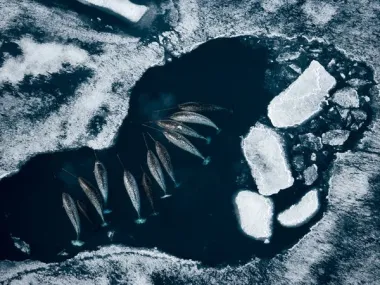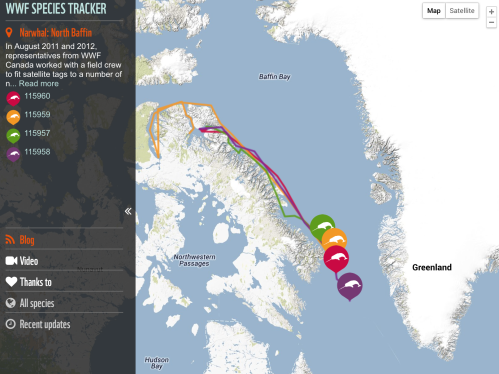
A Pod Of Narwhals, Roaming Freely Rather Than In A Zoo/Protection Center
The Narwhal species is currently at its lowest population in history, teetering on the edge of endangerment with only 50,000 narwhals left in the world. Unfortunately, large scale conservation efforts have not been put in place for the preservation of this great species. However, two significant laws have been established to protect the population:
First, narwhals are illegal to hunt unless the hunter is part of the Inuit Tribe (the local tribe that relies on narwhals to be a source of nutrients in its diet). The second law states that each hunter in the Inuit Tribe is limited to the killing of five narwhals per calendar year. These laws dramatically reduce the amount of narwhals killed by their greatest predators–humans. Both of these laws fall under the 1976 Narwhal Protection Regulations, produced as part of the Canadian Fisheries Act. This contains legislation that grants total protection of mothers and calves, and requires that full use be made of narwhal carcasses, as well as requiring the full documenting and labeling of every tusk obtained. However, these regulations are sometimes poorly enforced. The Narwhal is partially protected by this act in the United States, Russia, Greenland, and Norway.
A primary challenge in the protection of the Narwhal species is a fundamental lack of knowledge. Due to harsh climates and limited natural resources, the narwhal’s habitat is sparsely populated. Several large organizations have attached satellite tags to thousands of narwhals. These tags are used to track the movements and behavior of these animals. With this information, researchers are obtaining more and more information about the species in order to help with conservation efforts.
In addition to these trackers, the World Wildlife Fund (WWF) suggests that people become solar dependent to preserve the habitat of narwhals and other species. The WWF also enables individuals to “adopt” a whale. The profits from these “adoptions” lead to the expansion of rehabilitation efforts for whales, and specifically, narwhals.




Hey Jacob, another excellent page with lots of great information on it. Just a couple of sentences that need restructuring. “Unfortunately, large scale conservation efforts have not been put in place for the preservation of this great species. However, two significant laws have been put in place to protect the population.” This reads awkwardly because you used “put in place” twice. Try rewording these sentences.
“A primary challenge in the protection of” should say “A primary challenge to the protection of”.
Great work!
LikeLike
Hi Jake, you page is very good. One suggestion that I have is in the paragraph starting with the “narwal species” you might want to spill it up because it is a very long paragraph and put a pic in-between.
LikeLike
Jake the first Paragraph on the pages is a little big, but otherwise great website!
LikeLike
Jake your website has really great information it looks really really good so far! But maybe put an image or split the first two paragraphs into smaller paragraphs because they are a little lengthy. But other than that awesome job!
LikeLike
Thank you very much Jake! Im doing a project on narwhals and this was VERY helpful!😀😀😀😀😁😁😁😁
LikeLike